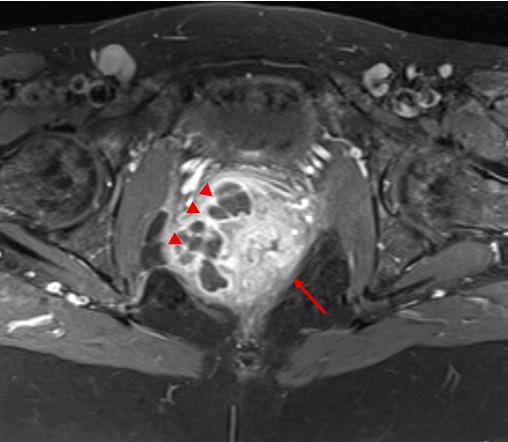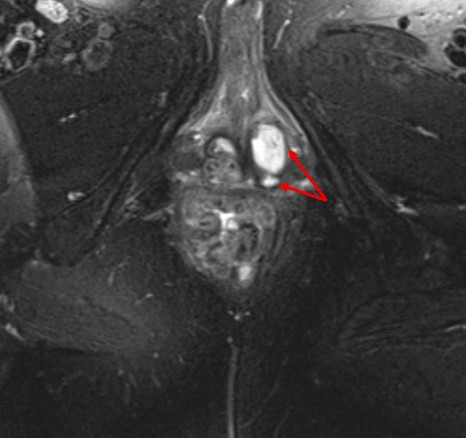Sunday Poster Session
Category: IBD
P1236 - More Than Just an Abscess: An Unusual Case of Rectal Squamous Cell Carcinoma
Sunday, October 26, 2025
3:30 PM - 7:00 PM PDT
Location: Exhibit Hall

Lan Nguyen, DO
University at Buffalo
Buffalo, NY
Presenting Author(s)
Lan Nguyen, DO1, Yu An Lin, DO2, Xavier Zonna, DO1, Clark Zhang, MD1, Erin Ly, MD1
1University at Buffalo, Buffalo, NY; 2Rutgers New Jersey Medical School, Newark, NJ
Introduction: Squamous cell carcinoma of the gastrointestinal tract most commonly affects the esophagus or anal canal. Rectal squamous cell carcinoma (rSCC) is exceptionally rare, comprising only 0.1% - 0.25% of cases. Its rarity often leads to misdiagnosis that delays patient care. We present a case of rSCC initially mistaken as Crohn’s disease, highlighting the importance of including rSCC in the differential diagnosis for perianal abscesses, especially after inflammatory bowel disease has been ruled out.
Case Description/
Methods: A 39-year-old female with no significant past medical history presented with nine months of painful perianal swelling. Physical exam revealed two perianal openings with minimal bleeding and mucus drainage. While laboratory workup was unremarkable, abdominal CT identified perirectal fluid collections concerning for abscesses or fistulas. Sigmoidoscopy revealed rectal erythema with only chronic inflammation on biopsy. The patient was treated with doxycycline but continued to develop increased pain and a new labial swelling. Labs at this time showed WBC 14, CRP 10.75, and fecal calprotectin 223. Pelvic MRI demonstrated complex right perirectal and left labial abscesses. Corticosteroids were started for presumed Crohn’s disease. However, repeat sigmoidoscopy was performed, with biopsies unexpectedly revealing moderately differentiated rSCC. Following a negative metastatic workup, the patient underwent diverting colostomy and chemoradiation, with marked tumor reduction after six weeks.
Discussion: The pathogenesis of rSCC is poorly understood, with chronic inflammation, epithelial damage, and squamous metaplasia being potential contributors. While HPV- particularly type 16- has been reported in several cases, its role remains controversial. rSCC can mimic rectal adenocarcinoma, presenting with altered bowel habits, rectal bleeding, and weight loss. It may also present atypically, as in this case, resembling perianal fistulizing Crohn’s disease. Diagnosis requires a high index of suspicion, especially in patients with recurrent perianal abscesses unresponsive to standard therapy. Endoscopy with biopsies is critical to confirm malignancy, while imaging such as endorectal ultrasound helps assess tumor extent. Surgical resection is the primary treatment for rSCC, although chemoradiation has shown favorable outcomes in select patients. This case emphasizes the importance of considering rSCC in patients with treatment-resistant perianal abscesses to enable timely diagnosis and intervention.

Figure: Figure 1. Pelvic MRI: Axial view showed a perirectal collection (arrow) with multiple septations seen within the right hemipelvis (arrowheads)

Figure: Figure 2. Pelvic MRI: Axial view showed a multilobulated left labial abscess (arrows)
Disclosures:
Lan Nguyen indicated no relevant financial relationships.
Yu An Lin indicated no relevant financial relationships.
Xavier Zonna indicated no relevant financial relationships.
Clark Zhang indicated no relevant financial relationships.
Erin Ly indicated no relevant financial relationships.
Lan Nguyen, DO1, Yu An Lin, DO2, Xavier Zonna, DO1, Clark Zhang, MD1, Erin Ly, MD1. P1236 - More Than Just an Abscess: An Unusual Case of Rectal Squamous Cell Carcinoma, ACG 2025 Annual Scientific Meeting Abstracts. Phoenix, AZ: American College of Gastroenterology.
1University at Buffalo, Buffalo, NY; 2Rutgers New Jersey Medical School, Newark, NJ
Introduction: Squamous cell carcinoma of the gastrointestinal tract most commonly affects the esophagus or anal canal. Rectal squamous cell carcinoma (rSCC) is exceptionally rare, comprising only 0.1% - 0.25% of cases. Its rarity often leads to misdiagnosis that delays patient care. We present a case of rSCC initially mistaken as Crohn’s disease, highlighting the importance of including rSCC in the differential diagnosis for perianal abscesses, especially after inflammatory bowel disease has been ruled out.
Case Description/
Methods: A 39-year-old female with no significant past medical history presented with nine months of painful perianal swelling. Physical exam revealed two perianal openings with minimal bleeding and mucus drainage. While laboratory workup was unremarkable, abdominal CT identified perirectal fluid collections concerning for abscesses or fistulas. Sigmoidoscopy revealed rectal erythema with only chronic inflammation on biopsy. The patient was treated with doxycycline but continued to develop increased pain and a new labial swelling. Labs at this time showed WBC 14, CRP 10.75, and fecal calprotectin 223. Pelvic MRI demonstrated complex right perirectal and left labial abscesses. Corticosteroids were started for presumed Crohn’s disease. However, repeat sigmoidoscopy was performed, with biopsies unexpectedly revealing moderately differentiated rSCC. Following a negative metastatic workup, the patient underwent diverting colostomy and chemoradiation, with marked tumor reduction after six weeks.
Discussion: The pathogenesis of rSCC is poorly understood, with chronic inflammation, epithelial damage, and squamous metaplasia being potential contributors. While HPV- particularly type 16- has been reported in several cases, its role remains controversial. rSCC can mimic rectal adenocarcinoma, presenting with altered bowel habits, rectal bleeding, and weight loss. It may also present atypically, as in this case, resembling perianal fistulizing Crohn’s disease. Diagnosis requires a high index of suspicion, especially in patients with recurrent perianal abscesses unresponsive to standard therapy. Endoscopy with biopsies is critical to confirm malignancy, while imaging such as endorectal ultrasound helps assess tumor extent. Surgical resection is the primary treatment for rSCC, although chemoradiation has shown favorable outcomes in select patients. This case emphasizes the importance of considering rSCC in patients with treatment-resistant perianal abscesses to enable timely diagnosis and intervention.

Figure: Figure 1. Pelvic MRI: Axial view showed a perirectal collection (arrow) with multiple septations seen within the right hemipelvis (arrowheads)

Figure: Figure 2. Pelvic MRI: Axial view showed a multilobulated left labial abscess (arrows)
Disclosures:
Lan Nguyen indicated no relevant financial relationships.
Yu An Lin indicated no relevant financial relationships.
Xavier Zonna indicated no relevant financial relationships.
Clark Zhang indicated no relevant financial relationships.
Erin Ly indicated no relevant financial relationships.
Lan Nguyen, DO1, Yu An Lin, DO2, Xavier Zonna, DO1, Clark Zhang, MD1, Erin Ly, MD1. P1236 - More Than Just an Abscess: An Unusual Case of Rectal Squamous Cell Carcinoma, ACG 2025 Annual Scientific Meeting Abstracts. Phoenix, AZ: American College of Gastroenterology.
